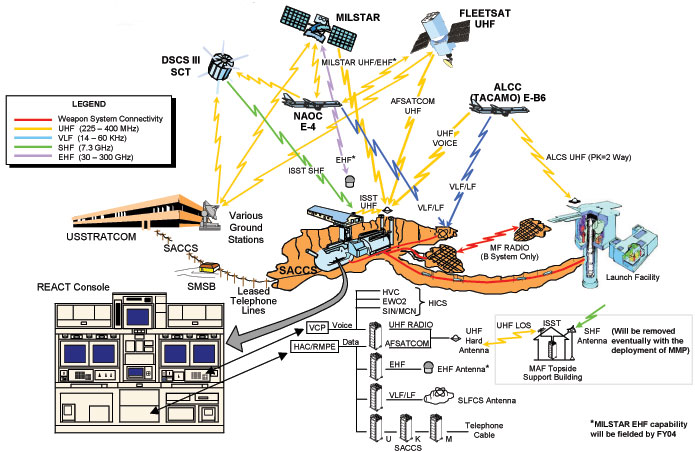Minuteman Communications Network
If an act of aggression occurs and the president authorizes retaliation with the ICBM Force, US Strategic Command (USSTRATCOM) will immediately issue instructions through critical communications systems to selected USSTRATCOM Command Posts (CPs) to launch missiles against specified targets. In turn, each CP will pass a coded message via its communications system to one or more of the Launch Control Centers (LCCs) under its jurisdiction.
The Minuteman Weapon System employs multiple communications systems that provide links from the National Command Authority through USSTRATCOM and directly to the missile LCCs. There are two major communications system groups: Higher Authority Communications and Minuteman Command and Control Systems.
The Higher Authority Communications Network consists of complementary communication systems between higher authority and all LCCs. This network of diverse communications links provides the survivable command capability vital to overall weapon system effectiveness. The digital communication systems interface with the Rapid Execution and Combat Targeting (REACT) Higher Authority Communications/Rapid Message Processing Element (HAC/RMPE) for message receipt, processing, generation, and transmission. Commands and alert exercises are normally transmitted via the Strategic Automated Command and Control System (SACCS) which uses the commercial telephone and land-line network. The Ultra High Frequency (UHF), Air Force Satellite Communication System (AFSATCOM), Military Strategic Tactical and Relay (MILSTAR) UHF, ICBM Super High Frequency Satellite Terminal (ISST), and Survivable Low Frequency Communication System (SLFCS) radio systems provide assurance that higher authority communications will be maintained even if land-line service is lost. SLFCS and AFSATCOM will eventually be replaced by the Minuteman MEECN Program (MMP) which will install survivable MILSTAR EHF capability to the LCCs. The communications systems are exercised regularly to ensure readiness.
The Minuteman Command and Control System is the final command link from the LCCs to the missile LFs. This network consists of squadron wide, hardened, command/control, and status monitoring systems. The system provides the capability for any LCC to control all LFs in the squadron. The various command and control system functions include secure command and control communications, squadron-wide monitoring, missile launch, operational testing, and remote targeting. Squadron wide command and control is accomplished by message transmission over the hardened intersite cable system (HICS). The HICS is a hardened buried cable network providing communication paths between LCCs and LFs. At wing I Squadron 20, the Medium Frequency (MF) radio system complements the HICS in providing intra-squadron command and control system interconnectivity.
Squadron Command and Status CommunicationsThe squadron Command and Status Communications System consists of the hardened intersite cable system and the MF radio systems that connect MAFs and LFs. The cable systems are buried to help provide protection from nuclear effects. The WS-133A-M system uses redundant cable paths in a wagonwheel-spoke configuration with the MAF at the center and four radial cable runs out to the ring trunk. Inter-flight connectivity is also provided by buried cable.
The WS-133B system located at Wing I Squadron 20 uses a single backbone cable with cable runs stubbed off to the LFs. The B system has an MF radio overlay to the the cable system to provide the command and status messaging redundancy between LFs and LCCs as well as between flights.
Each MAF has primary control and responsibility for the 10 LFs within its flight. A squadron is comprised of five flights. Each of the five MAFs also has the ability to command and monitor all 50 LFs within the squadron.

Minuteman Communications Network